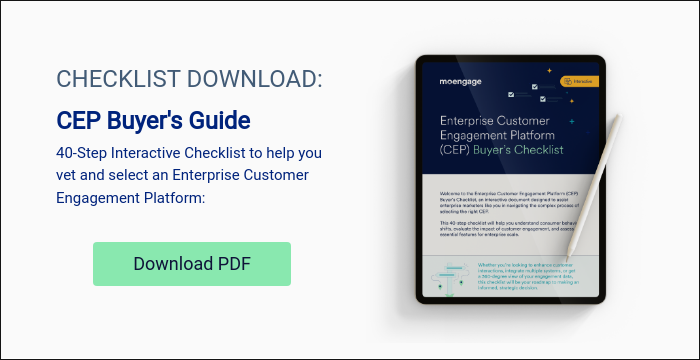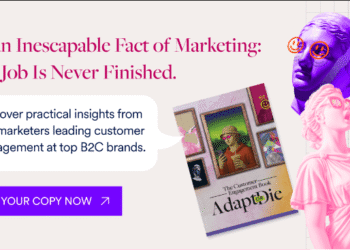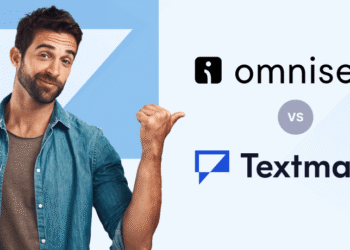Reading Time: 21 minutes
You may have had it with Oracle Responsys’ clunky modules, limited channels, and extra charges for features that should be standard. Legacy systems, right? Or you may have got wind of these issues from your fellow B2C marketers. Either way, you’re on the lookout for Oracle Responsys competitors. Period.
The good news? The world is your oyster.
You’ll find plenty of smart, modern small, medium, and enterprise Customer Engagement Platforms (CEPs) built to orchestrate campaigns across every channel your customers use. The trick is to know which platform checks your team’s boxes now and scales with your team tomorrow.
On that note, let’s look at the top Oracle Responsys alternatives that B2C marketers like you are turning to, and why.
11 Best Oracle Responsys Competitors for Customer Engagement
The Oracle Responsys alternatives on this list solve the frustrations Oracle is known for when it comes to customer engagement. Some unlock more engagement channels than Oracle does, while others leverage AI to keep optimizing campaigns while you focus on strategy.
Here’s the scoop on what these platforms are and what makes them the best alternatives to Oracle.
1. Best for AI-powered omnichannel engagement: MoEngage
MoEngage stands tall among the strongest Oracle Responsys competitors because of its true omnichannel marketing automation. You can orchestrate campaigns across 10+ channels from a single dashboard. On top of that, its AI engine, Merlin AI, analyzes patterns, predicts the best way forward for each segment, and adjusts campaigns fast.
Cost: MoEngage’s pricing is flexible, based on your channel usage and active contact base. It’s free for up to 10K Monthly Tracked Users (MTUs), and it offers two pricing plans — Growth and Enterprise.
G2 Score: 4.5/5
Channels: Email, SMS, RCS, mobile and web push notifications, in-app messaging, on-site messaging, WhatsApp, web personalization, Facebook Audience, and Google Ads Audience.
Standout Feature: Intelligent Path Optimizer that tests up to five customer journey branches at once. MoEngage’s AI automatically shifts traffic toward the winner.
Why It’s Best for AI-powered Omnichannel Engagement: MoEngage empowers B2C marketers like you to leverage AI to keep improving customer engagement across channels without increasing manual workload.
What MoEngage Has that Oracle Responsys Doesn’t:
We sourced all of this information directly from Oracle Responsys’s website, with references, and it is accurate as of November 2025:
A) Web personalization
Oracle Responsys doesn’t offer built-in web personalization, but with MoEngage, it’s native.
You can change homepage banners for each customer based on their browsing history, location, and past purchases. You can also localize entire page layouts depending on geographic regions.
Additionally, it lets you highlight best-selling products for loyal customers or surface first-purchase discounts for new customers without a developer.
A/B or multivariate tests on layouts or CTAs can be launched instantly. You can measure them directly in the MoEngage dashboard and continuously optimize them.
B) On-site messages
Oracle Responsys focuses heavily on five channels: email, mobile and web push notifications, in-app messages, and SMS/MMS.
MoEngage, on the other hand, bakes in on-site campaigns, along with the channels that Responsys supports. It lets you trigger a pop-up promo the moment a customer scrolls further down your product page.
Because these experiences happen during the flow of the customer journey, you capture attention when your customers are most likely to convert.
Another benefit of MoEngage is that these on-site campaigns live alongside your other channels, letting you coordinate timing and targeting for maximum engagement.
C) AI copy and image generation
Oracle Responsys has no native AI to instantly produce on-brand messaging and images. Its Subject Line Predictions for Email and Push Title Optimization can only predict which titles (push notifications) and subject lines (email) would have higher open rates. But for the subject line prediction feature to work, you need to update at least 300 unique subject lines.
In contrast, MoEngage’s Merlin AI does more than automation. From email subject lines and preview text to push, in-app and on-site messages, Merlin AI Copywriter makes copy suggestions optimized for better campaign performance based on past data.
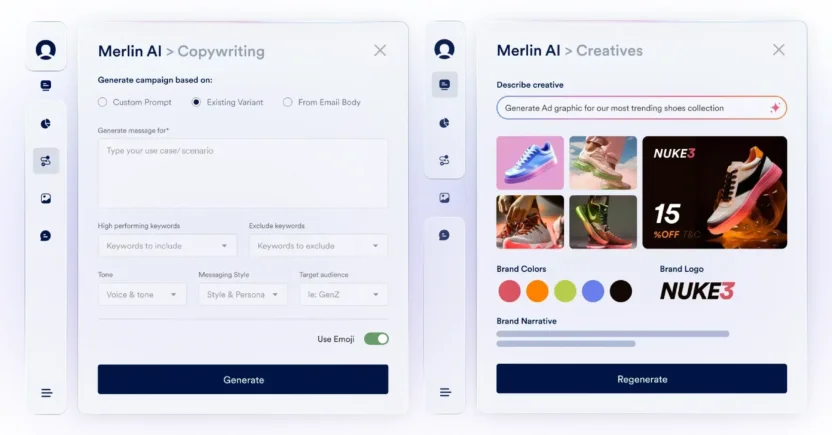
Using Merlin AI Designer, you’ll get multiple image variations and product descriptions for different audience segments, too. This gives you the ability to use the AI to speed up content testing, so you can launch same-day, instead of waiting for creative teams to deliver.
For example, travel and hospitality giant Thomas Cook sends an average of 5 holiday package promotions daily. Each campaign needs a different visual.
Manually designing the creatives took them 2 to 3 hours, which added to the lengthy revision cycles. The creative slowdown stunted their ability to respond fast to popular trends.
With Merlin AI Designer, the Thomas Cook team now creates visuals for their push notification campaigns in 5-10 minutes. Just a few lines of prompt, and their on-brand visuals are ready. As a result, their campaigns go live 90% faster than before.
As shared by Shubham Jain, Marketing Manager at Thomas Cook:
Since leveraging Merlin AI Designer for our Push Notification campaigns, we’ve been able to create images on the fly, a process that used to take hours.
It’s like having a strategist, designer, and copywriter all rolled into one — someone who’s instantly available and trained on your customer engagement data.
D) PII Tokenized Sending
Oracle Responsys masks customers’ Personally Identifiable Information (PII) from the end users through its Data Redaction feature — similar to MoEngage’s PII Masking feature. And, like our PII Data Encryption, Responsys also encrypts the data to prevent unauthorized users from accessing it.
But that’s about it. There’s no additional layer of security to protect customer data in Responsys.
There is in MoEngage, though.
With our PII Tokenized Sending, you can engage with your customers through email, SMS, RCS, and WhatsApp, without having to store their sensitive data in MoEngage’s platform. The data is translated into anonymous tokens, and you can fetch that data in real-time only when you’re sending campaigns.
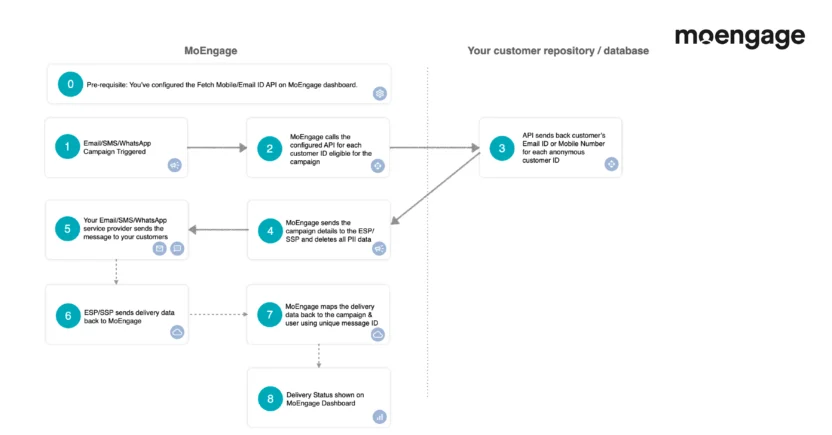
E) Dynamic content generation using natural language
To produce highly personalized messages in Oracle Responsys across email and web, you need to know Responsys Personalization Language (RPL). It’s similar to a programming language and generates text output based on templates.
As if implementing advanced personalization wasn’t time-consuming already!
Luckily, MoEngage’s Merlin AI Jinja Assistant simplifies the implementation of dynamic content and personalization for your campaigns. How?
Well, it basically lets you prompt what you need in plain English. Based on those natural language queries, it generates personalized Jinja code snippets with clear explanations. So, even if you don’t know Jinja, the explanations can help you understand and learn it effectively.
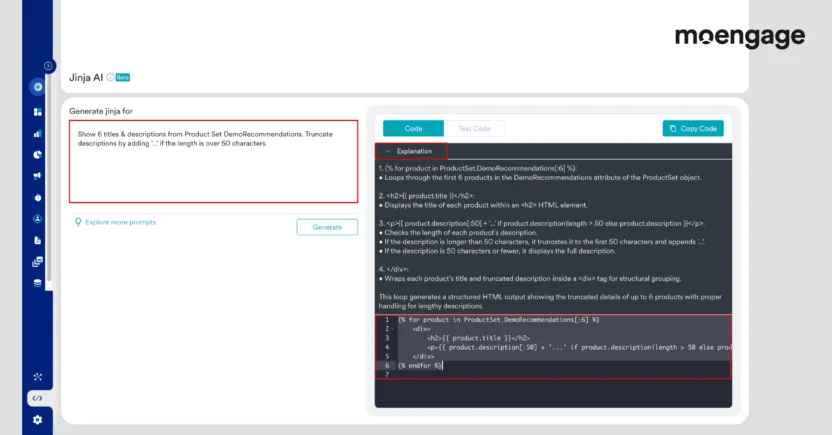
The rest of the work is easier. You just need to test the Jinja code and fix it with AI in case of errors. Finally, copy and paste the code into the appropriate personalization fields within your campaign templates. Congrats, you’re all set!
Even though we’ve explained the differences between MoEngage and Oracle Responsys, there are other alternatives to Oracle Responsys worth exploring.
2. Best for basic automated campaigns: Constant Contact
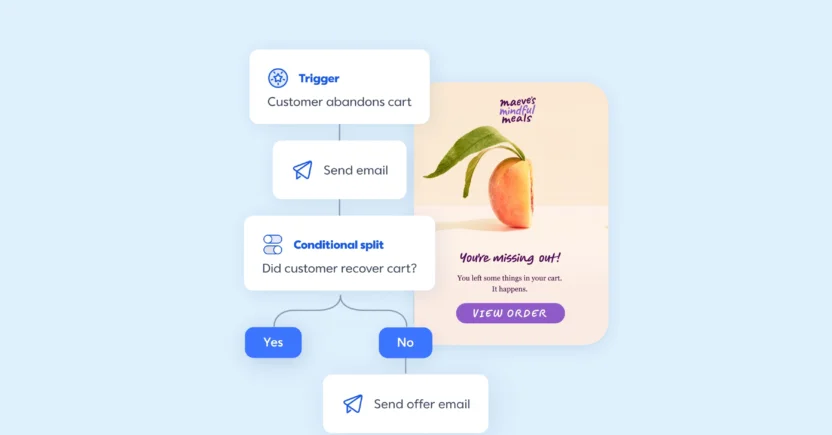
If you’re an early-stage startup or a smaller B2C brand looking to dip your toes into marketing automation without battling complexities head-on, Constant Contact is a crowd favorite. From growing your subscriber list to driving sales, it helps you keep your customers engaged across multiple touchpoints.
Sure, you can set up autoresponders and build basic drip campaigns. But don’t expect the flexibility and depth that come with complex automated email workflows. Its SMS functionality has restrictions, such as preventing you from using pre-approved contact lists. There are occasional lags in the UI, too.
Cost: Its pricing increases with the size of your contact list, with SMS being sold as an add-on under all three tiers. For instance, 30K-35K contacts cost $380 to $485 per month, while 45K-50K contacts run $430 to $575 each month.
G2 Score: 4.1/5
Channels: Email, SMS (for US customers only), and social media
Standout Feature: Text-to-join, which lets customers simply text your brand to opt in to your email or SMS campaigns.
Why It’s Best for Basic Marketing Automation: Launching quick, no-frills campaigns with Constant Contact is easy. So even if you’re new to marketing automation, you can get moving fast.
3. Best for email templates: MailerLite

An email marketing automation platform, MailerLite helps you build forms, landing pages, pop-ups, and websites. Tailor every interaction to your customers’ needs with dynamic content and advanced personalization. You can also try multivariate and A/B testing to identify the best emails, landing pages, and forms.
But MailerLite’s simple drag-and-drop builder lacks flexibility and advanced visual options. Sometimes, it doesn’t save the custom font colors for a campaign you’re running. You can’t change the font of a specific part of the email copy, either. This makes it difficult to edit email campaigns.
Cost: MailerLite offers a 14-day free trial for up to 1K subscribers, with access to premium features. Once it ends, you’ll have two options to choose from. It’s either the Free plan to send 12K monthly emails, or the paid plans starting at $65.70/ mo for unlimited monthly emails to 10K subscribers. For over 100K subscribers, you can reach out to the sales team.
G2 Score: 4.6/5
Channels: Email and SMS
Standout Feature: Multi-trigger email automation, enabling you to add up to 3 triggers for each automation in a workflow.
Why It’s Best for Email Templates: MailerLite has over 150 templates that you can easily customize with its intuitive drag-and-drop builder.
4. Best for automated email sequences: Keap
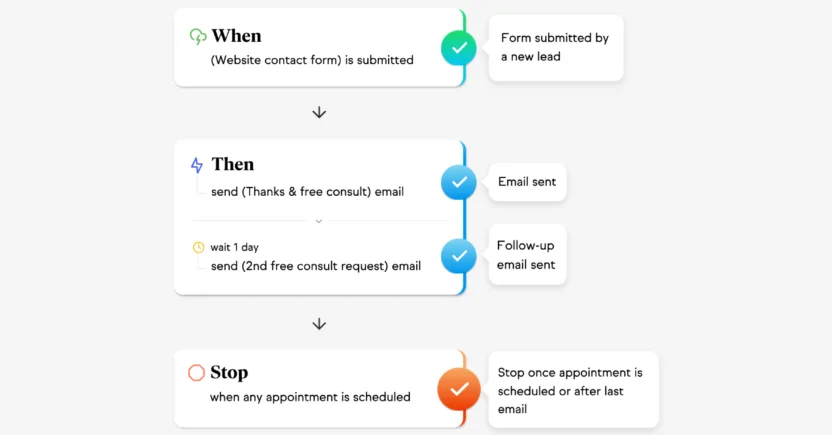
Keap, a Thryv, Inc. brand, is a marketing and sales automation platform with a built-in CRM. Designed specifically for small businesses, it helps you easily capture, organize, nurture, and track your leads.
However, the platform’s supportive documentation isn’t clear enough for non-technical marketers to understand. A few Keap users have also complained about its email deliverability not hitting the mark. They’ve seen high email bounce rates and spam complaint rates, with little help from support.
Cost: At the end of Keap’s 14-day free trial, the pricing grows with the number of users and contacts. For 2 users and 1,500 contacts, the price starts at $299/ mo, billed monthly. For 11,500 contacts, Keap charges $539/ mo. You need to reach out to their team if you have more than 50K contacts. A one-time implementation fee of $500 is added to the cost, which covers strategy calls, data import, migration services, and up to 2 third-party tool integrations.
G2 Score: 4.2/5
Channels: Email and SMS
Standout Feature: AI Content Assistant to compose emails fast with AI.
Why It’s Best for Automated Email Sequences: Keap’s automated sequences are easy to set up. From welcome and confirmation emails to newsletters, you can trigger a personalized nurture series using segmentation.
5. Best for developer-friendly push notifications: Knock
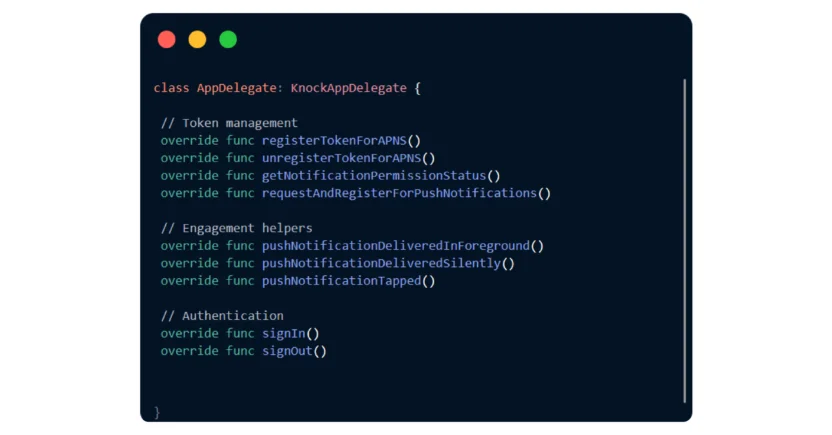
Knock provides the infrastructure for sending cross-channel lifecycle messaging and product notifications to customers. From automating cross-channel workflows to allowing notification preferences, it helps you drive growth and retention.
The downside is that Knock is a developer-first platform. If you aren’t tech-savvy, you may find a steep learning curve during initial setup. Editing templates can take longer than expected, as the visual editor doesn’t always give you the flexibility you need. The workaround for that issue is to use the HTML editor, which, again, means dev dependency.
Cost: Knock is free for up to 10K monthly notifications. This plan works for small-scale deployments or if you need to just test and evaluate the system. For 50K monthly notifications, the pricing starts at $250/ mo. Any more notifications, and you need to contact the sales team.
G2 Score: 4.6/5
Channels: Push notifications, SMS, in-app messaging, and email
Standout Feature: An API-first workflow engine to power lifecycle and transactional messaging across channels.
Why it’s Best for Developer-Friendly Push Notifications: You can build push notifications using developer-ready Android and iOS SDKs, like Flutter, React Native, and Swift. It allows you to either customize components to make the notifications on-brand or use pre-built styling.
6. Best for SMS workflows: EZ Texting

Use effective text messages to build mobile audiences with EZ Texting. This SMS marketing software platform has a user-friendly interface, not to mention top-tier support. That’s what makes it one of the top Oracle marketing cloud competitors.
But sometimes, text messages go missing or take time to show up on the dashboard. You might also get charged unnecessary message credits for all the phone numbers in your database, including those that are out of service.
Cost: EZ Texting offers four pricing plans, ranging between $20/ mo for up to 500 contacts, and $3K/ mo for over 50K contacts. The messages sent are credit-based, varying in terms of message length. Each SMS to each contact would cost a credit. Every MMS to a contact would cost 3 credits.
G2 Score: 4.5/5
Channels: SMS and MMS
Standout Feature: Link Tracker & Shortener to monitor clicks in SMS messages and understand which messages drive more action than others.
Why It’s Best for SMS Workflows: EZ Texting’s drag-and-drop editor makes it easy to launch automated workflows in minutes. It also houses a library of pre-built templates that leverage conditional logic. So sending welcome messages, appointment and cart abandonment reminders, review requests, and event promotions becomes effortless.
7. Best for A/B testing emails: Mailchimp
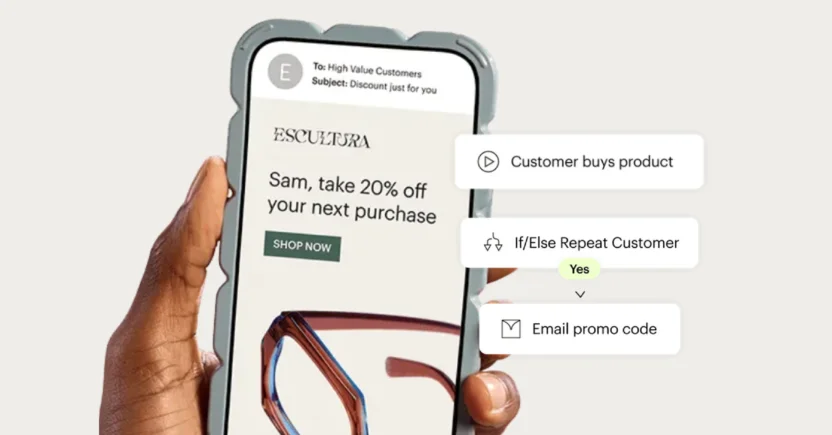
If you want to launch automated email marketing campaigns without a steep learning curve, Mailchimp is one of the most approachable Oracle Responsys competitors. Its drag-and-drop editor makes building emails painless. At the same time, its segmentation and personalization filters let you send the right message to the right customer.
However, some Mailchimp users have reported occasional downtime during peak hours. Its pre-designed email templates can feel restrictive, too, unless you’re comfortable working with HTML. And the biggest disadvantage of all — there’s no way for you to launch real omnichannel campaigns. Why? Because the only channels that Mailchimp supports are email, MMS (only under US paid plans), and SMS (only in the US and the UK under paid plans).
Cost: The Free plan lets you send up to 500 emails a day or 1K a month to 500 contacts. But email support drops off after 30 days, and you lose features like behavioral targeting and A/B testing. Paid plans start at $8.86/ mo for 500 contacts and can go up to $972.25/ mo for 200K contacts.
G2 Score: 4.4/5
Channel: Email, MMS (only under US Premium and Standard plans), and SMS (only under US and the UK paid plans)
Standout Feature: Subject Line Helper to help you write compelling email subject lines.
Why It’s Best for A/B Testing Emails: Mailchimp makes email A/B testing (including different images, subject lines, email layouts, and send times) quick to set up and easy to manage for small teams.
8. Best for CRM integrations: Adobe Marketo Engage

Competing head-to-head with Oracle Responsys in the enterprise marketing automation space, Adobe Marketo Engage has deep CRM ties. It helps B2C lifecycle marketers move customers smoothly long their journeys, and is built to connect marketing and sales functions.
But there’s a catch. While its CRM integrations are powerful, its day-to-day execution can feel sluggish. Managing assets, pulling reports, and doing other basic tasks may take longer than expected. New Adobe users often face a steep learning curve. Considering its huge price tag, these friction points stand out even more.
Cost: Pricing is organized into four tiers and scales with your contact database size. Advanced capabilities, like journey analytics, and certain channels like SMS, mobile push, and web personalization are sold as add-ons.
G2 Score: 4.4/5
Channels: Email, webinars, SMS, display ads, social channels (Facebook, X, and LinkedIn), web, Adobe Dynamic Chat, and mobile push notifications.
Standout Feature: Advanced account-based audience matching to create hyper-targeted ad campaigns.
Why It’s Best for CRM Integrations: Its native, enterprise-grade CRM connections give B2C marketing and sales teams a shared source of truth, so they can shorten the customers’ paths from interest to conversion.
9. Best for data mapping: Salesforce Marketing Cloud
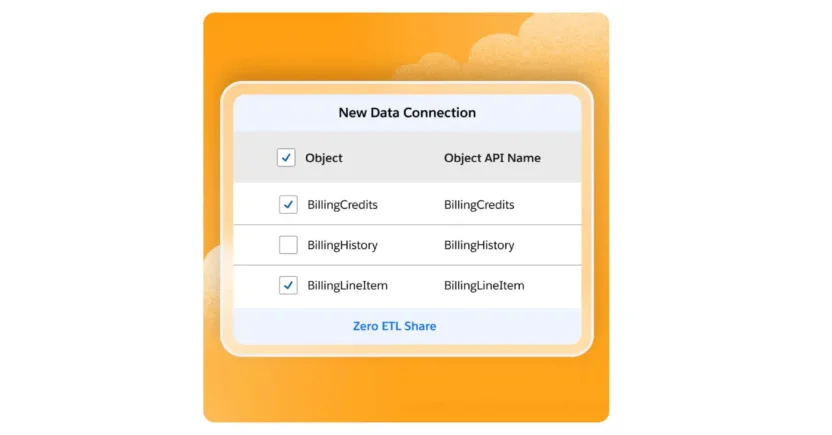
As one of the Oracle Responsys competitors, Salesforce Marketing Cloud is built for brands that want to make the most of their customer data at scale. With native integration into Salesforce CRM, you can automatically sync every interaction into a unified customer profile. That’s a single source of truth powering data-driven journeys across channels.
However, you might find it confusing to navigate the platform. Also, each of its numerous modules needs certification before you can even begin to understand its ins and outs.
Cost: The Salesforce Starter Suite begins at $25/ mo per user and includes analytics, integrated Slack conversations, and dynamic email marketing. The Marketing Cloud Growth Edition ($1,500/ mo) adds landing pages, full multi-channel journeys, and forms. At the top, the Marketing Cloud Advanced plan ($3,250/ mo) unlocks path experimentation tools, unified conversational SMS, and AI scoring.
G2 Score: 4.4/5
Channels: Email, SMS, LINE, mobile push notifications, in-app messages, web personalization, WhatsApp, social media, and ads
Standout Feature: Paid media optimization tools that recommend ways to improve underperforming ads after automatically pausing them.
Why It’s Best for Data Mapping: Salesforce blends structured and unstructured data from Google, AWS, Databricks, and Snowflake into its Data Cloud to keep the targeting precise.
10. Best for customer segmentation: Iterable
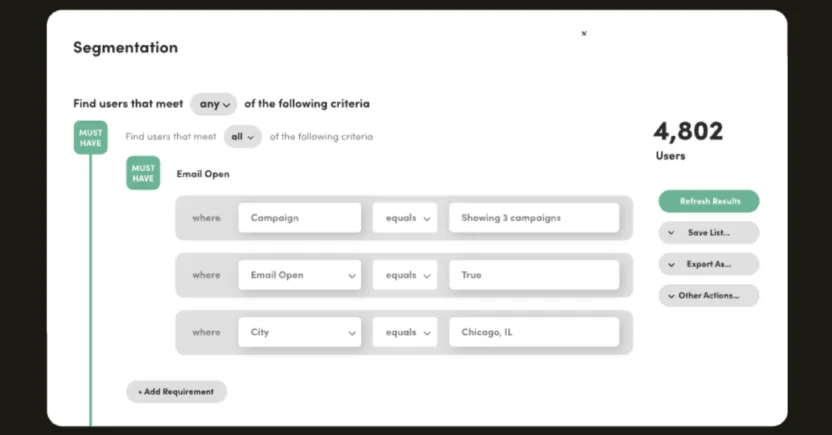
Iterable is an email-first customer communication platform, built for marketers who want to segment customers quickly and precisely. It’s an intuitive platform and easy to navigate for some first-time users.
However, you may hit a wall when you need to create on-brand or visually rich emails. Iterable’s email templates aren’t flexible enough for that. Nor does it allow customizable analytics reporting. You might also experience an occasional lag when handling complex automated workflows or huge datasets. No wonder marketers who need to go beyond segmentation look for alternatives to Iterable.
Cost: Iterable charges for all contacts in the database, including unsubscribed and inactive ones. It also adds extra fees for channels like mobile and web push notifications and in-app messages.
G2 Score: 4.4/5
Channels: Email, SMS, push notifications, in-app messaging, WhatsApp, on-site or in-browser messages, and Roku.
Standout Feature: Iterable Nova, an AI agent to generate personalized content and optimize campaigns.
Why It’s Best for Customer Segmentation: Iterable’s segmentation is flexible, allowing you to create granular, behavior-based audiences quickly.
11. Best for user-friendly navigation: Braze
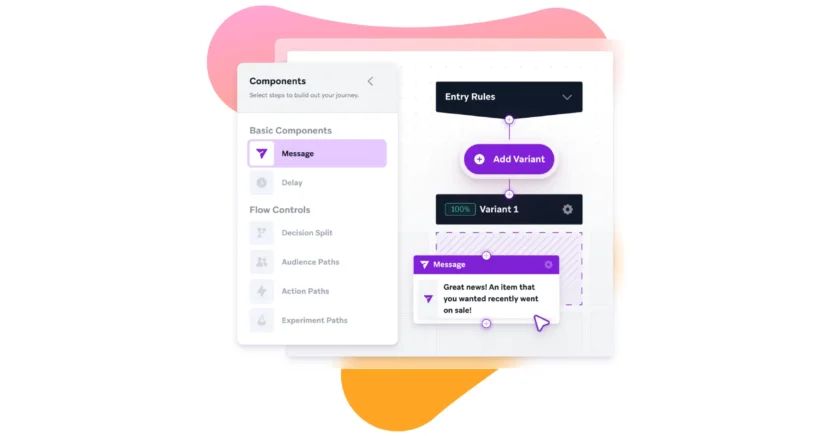
What makes Braze one of the Oracle Responsys competitors on this list is its interface that feels as intuitive as it is powerful. With structured onboarding and well-written documentation, even non-technical B2C marketers can get campaigns live fast.
However, some Braze users run into challenges while integrating the platform with complex legacy systems. In addition, its drag-and-drop builder and pre-designed templates are available only for email. So, launching campaigns on other channels might take time.
For workarounds, why don’t you explore alternatives to Braze?
Cost: A bit vague on pricing, Braze offers an Enterprise plan that’s custom-priced. It also includes broader integrations, more advanced capabilities, and dedicated support.
G2 Score: 4.5/5
Channels: Email, SMS, RCS, mobile app, web, LINE, and WhatsApp
Standout Feature: Cost-based channel segmentation to automatically prioritize lower-cost channels before tapping into premium ones.
Why It’s Best for User-Friendly Navigation: Braze’s clean, well-organized interface makes complex cross-channel marketing accessible, even for teams without deep technical resources.
5 Key Criteria to Consider When Choosing an Oracle Marketing Cloud Competitor
You can’t just pick any CEP that claims to be better than Oracle. You need to choose from the top Oracle Responsys competitors and pick the right one that won’t feel like a downgrade a year from now.
Because once you switch, you’ll want to stay for a long time. Who wants to go through the same migration hassles over and over again?
Not your team. So, here are five big criteria you should be clear about while weighing your options.
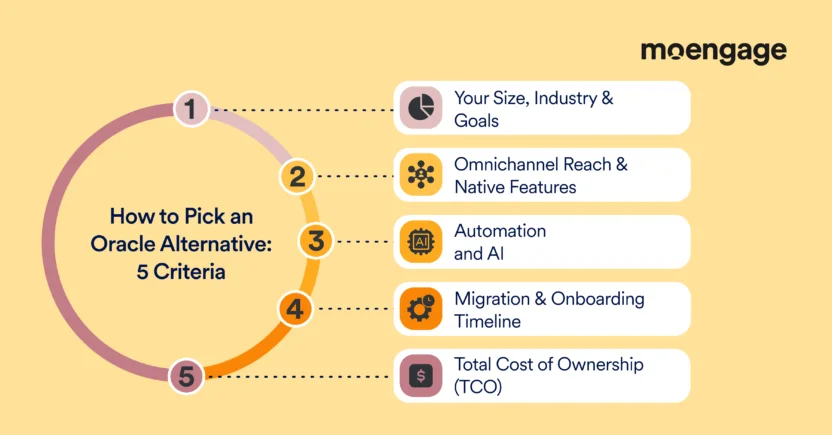
1. Fit for your industry, size, and goals
Not every platform is built for every type of brand. Some customer engagement tools are meant only for large enterprises, while others are perfect for fast-growth consumer brands.
The right fit means the Oracle Responsys alternative not only matches your current needs, but also has space for where you’re headed. If you ignore the latter, you’ll find yourself outgrowing the platform fast.
Questions to ask yourself about this when evaluating Oracle Responsys alternatives:
- Does the new customer engagement platform actually serve your industry and customer segments?
- Is it optimized for B2C lifecycle marketing?
- Can it scale to double or triple your database size without a painful migration?
- Are there case studies from brands similar to yours that have used this platform?
2. Omnichannel reach and native features
If the Oracle Responsys competitor can’t meet your customers where they are, then it’s a downgrade.
The more native channels you get, the more integrated your messaging gets. And it reduces the number of extra tools you have to pay for.
Questions to ask yourself about this when evaluating Oracle Responsys alternatives:
- Which engagement channels are included without add-on fees?
- Which channels does the platform have that Oracle doesn’t? Would they be useful?
- Can you orchestrate automated customer journeys across all channels from one dashboard?
- Are there unified channel performance dashboards?
3. Automation and AI
Marketing automation is a given now. Rule-based triggers are a market standard, but AI-driven decision-making can level up your campaign performance.
If an Oracle Marketing Cloud competitor can give you self-optimizing journeys, you can buy back your team’s time, to say nothing of performance.
Questions to ask yourself about this when evaluating Oracle Responsys alternatives:
- Does the platform predict engagement or conversions using AI, or only rules?
- Can it test multiple paths in real-time and adjust journeys accordingly?
- Does it learn from historical data and update recommendations for future campaigns?
- Will these marketing automation software features reduce your team’s workload?
4. Migration and onboarding
No marketer would ever prefer to spend their weekdays switching platforms. Much time is lost, campaigns are paused, and a learning curve slows your team down. But even more trouble brews when some platforms make the process a nightmare.
The smoother the onboarding process, the faster you can get back to running campaigns that drive revenue.
Questions to ask yourself about this when evaluating Oracle Responsys alternatives:
- How long does onboarding typically take, compared to Oracle Marketing Cloud?
- Does the platform offer migration tools for contacts, templates, and automations?
- Can your team learn navigating the interface fast?
5. Total Cost of Ownership (TCO)
Some platforms charge for premium features, the number of channels, extra user seats, or API usage.
Questions to ask yourself about this when evaluating Oracle Responsys alternatives:
- Which features or channels are standard, and which ones are add-ons?
- Are mission-critical channels (like web personalization) and features (like transactional messages) included?
- Will your cost include inactive or unsubscribed contacts too?
- How do the total costs (subscriptions, add-ons, and integrations) compare to Oracle’s?
Top 3 Oracle Responsys Alternatives Feature Comparison: How They Stack Up
Moving away from Oracle Responsys translates into choosing a platform that can handle today’s B2C customer engagement needs. That means more channels, smarter automation, and faster onboarding.
To make your life easier, we’ve compared the top three Oracle Responsys competitors and alternatives — MoEngage, Constant Contact, and MailerLite — with Oracle Responsys itself.
But the criteria aren’t random. We examined the factors that B2C marketers prioritize most when selecting a CEP.
Here’s how these engagement platforms stack up against each other:
| Criteria | Oracle Responsys | MoEngage | Constant Contact | MailerLite |
| G2 Score | 3.9/5 | 4.5/5 | 4.1/5 | 4.6/5 |
| Channels Supported | Only email, SMS, mobile & web push. | Email, SMS, mobile & web push, WhatsApp, RCS, in-app & on-site messaging, web personalization, Google Ads Audience & Facebook Audience. | Only email, social media & SMS (US only). | Only email & SMS. |
| AI Copy & Image Generation | Only Subject Line Predictions for Email & Push Title Optimization.
No AI content generation. |
AI Copywriter to generate email subject lines & preview text, push, in-app & on-site messages.
AI Designer for push image generation. |
AI Content Generator to write emails, landing pages, SMS & social captions.
No AI image generation. |
AI email generator to write emails & subject lines.
No native AI image generation. |
| Ease of Use | Complex; steep learning curve | Unified dashboard; marketer-friendly | Beginner-friendly | Beginner-friendly |
| Best For | Enterprises with single-channel or basic multichannel needs | B2C brands that need advanced AI-driven omnichannel engagement | Startups needing basic email & SMS | Marketers with email-focused engagement goals |
5 Migration Strategies When Switching to an Oracle Responsys Competitor
Switching to any of the Oracle Responsys competitors is a process that can either drag on for months or move fast and stress-free. The difference comes down to not just planning and accountability, but also to the right platform vendor.
That’s why you should have a customer engagement platform migration strategy in place. Let’s take a look at how to ensure a smooth migration to your new CEP.
1. Map out your migration plan
Break down the migration process into exact phases. Plan when you’d migrate customer properties, channel-based templates, event history, automation workflows, API integrations, and how long it would take. Decide early whether each piece would move over via API connection or be imported as a CSV file. MoEngage, for instance, provides hands-on migration support to help you move quickly.
After preparing timelines for every stage, assign your team and the new vendor’s team ownership of each part of the plan. Ensure the timelines are realistic, depending on your team’s bandwidth. Keep in mind that the duration would mostly depend on the volume of data that needs to be migrated.
2. Automate what’s possible
Still copying spreadsheets manually during migration? It’s time-consuming, to say the least.
This is the era of bulk imports, automated syncing, and direct API connections to your CRM, data warehouse, or Ecommerce platform. The more automated the transfer process is, the sooner your campaigns can get up and running on the new platform.
3. Document the migration process
You can’t afford to forget the special cases, weird setups, or workarounds you came across during migration. So, waiting until the end of the process to jot down how things work isn’t going to cut it.
Good documentation, paired with your vendor’s user and developer guides, can help you repeat the process later if needed. You can also quickly onboard new team members and bring them up to speed.
MoEngage, for example, supplies clear API and SDK references. So if and when you launch in new regions, scale to new channels, or re-sync data from an updated CRM, you won’t face any obstacles.
That’s how Drop, a card-linked rewards app, moved from setup to live campaigns with MoEngage in just 7 days. Because MoEngage’s APIs, SDKs, and backend integrations are well-documented, Drop could import historical data, sync customer events, and start sending campaigns quickly.
4. Test before the final switch
Nobody wants nasty surprises after flipping the go-live switch. To avoid getting one, build time for testing during migration, and not after.
Have each involved department run their core workflows in the new platform. Check how accurate the segmentation is and whether campaigns are being triggered correctly. Test and re-test personalization logic and automation paths.
MoEngage runs these tests with you throughout the process, making adjustments in real-time. Your first week live should be about performance, and MoEngage helps ensure you meet that goal.
5. Lean on post-migration onboarding support
Even with the smoothest migration, there’s still a bit of a learning curve. Ask your vendor to set up structured onboarding for your team by scheduling training sessions. Have them guide you while you’re getting hands-on with your first campaigns.
Set recurring check-ins with your customer success manager for at least the first few months. During these sessions, you can learn new features, review campaign performance, and troubleshoot any errors or issues.
That’s where MoEngage stands out. Our implementation team helps you optimize and scale to more channels, and is in the trenches with you long after the go-live date. For instance, our certified project managers helped SoundCloud seamlessly migrate 200 live campaigns in just 12 weeks. They also provided custom support to the SoundCloud team to familiarize them with the platform and help them solve any challenges they ran into while initially using MoEngage.
After this strategic shift, SoundCloud’s engagement was up by 15%. As Hope Barrett, Director of Product Management at SoundCloud, noted:
Here at SoundCloud, we consider MoEngage as a true partner with over 90+ team members across content, product and marketing using the platform on a daily basis to create, launch and deliver engaging experiences for our fans and artists.
Top 5 FAQs Answered About Oracle Responsys Alternatives
Feeling overwhelmed already?
We get it. That feeling’s normal when you’re shifting to something new.
To help ease your confusion, here are the most common questions B2C marketers ask before making the switch.
1. What are the main reasons B2C lifecycle marketers look for an Oracle Responsys competitor?
With Oracle Responsys (and similar legacy systems), B2C marketers typically face the following problems:
- Steep learning curves: You sometimes need module certifications just to complete basic tasks in the platform, making the learning curve steep, especially for new users. The platform is quite rigid, too, with users noting a lack of flexibility when trying to adjust to specific needs.
- Poor cross-channel synergy: Data and campaigns are split across modules, making cross-channel customer journey orchestration tougher.
- Slow implementation: It often takes months, if not more, to go live with the first campaign. Plus, building multiple emails can be slow sometimes, which can further push back campaign go-lives.
- Add-on fees: Legacy systems sometimes charge add-on fees for capabilities like transactional alerts, which should otherwise be standard.
2. How does customer engagement software like Oracle Marketing Cloud work?
Any customer engagement software platform typically works this way:
- It collects customer attributes (like name, location, email address, and purchase history) and behavior data (clicks, opens, and visits).
- It segments your audience based on those details.
- It helps you build and send campaigns across channels like email and SMS.
- It analyzes customer engagement metrics like campaign delivery and conversions, so you can optimize the campaign performance over time.
3. What are the biggest factors that affect the price of Oracle Responsys competitor customer engagement software?
The total cost often comes down to:
- Contact database size: Most customer engagement platforms price based on how many active contacts or customers you’re messaging.
- Channels used: Adding more channels like SMS, in-app, and on-site on top of email can increase costs. Some platforms, like MoEngage, include most channels in their core package, instead of charging for them separately.
- Messaging volume: Even if you have a fixed number of contacts in your database, the number of messages you send across different channels can bump up the costs.
- Features: Advanced capabilities like dynamic web personalization and AI optimization are often treated as premium features in legacy systems, driving up costs. They’re more likely to be included in the standard pricing of modern CEPs.
4. How should you price, compare, and shop for an Oracle Responsys alternative effectively?
Taking a systematic approach to choosing from Oracle Responsys competitors will help you quickly zero in on the right fit:
- Clarify your must-haves: Are you looking for a customer engagement platform that’s laser-focused on email and SMS? Or do you need broader capabilities like push notifications, and on-site and in-app messages?
- Weigh the features: Look at all the Oracle Marketing Cloud alternatives through the lens of channels supported, scalability, pricing model, implementation time, and overall usability for your marketing team.
- Dig into customer feedback: Independent review sites like Gartner, The Forrester Wave, and G2 can give you an idea of how satisfied real marketers are with the platform.
- Get hands-on experience: A free trial, sandbox environment, or even a live demo can tell you more about how it feels to use the platform than any feature or spec sheet ever can.
5. Why do B2C marketers prefer MoEngage over Oracle or other Oracle Responsys competitors?
Many marketing teams switch to MoEngage because it solves the pain points that hold them back on Oracle Responsys and similar legacy platforms:
- True omnichannel reach: Oracle only supports SMS, email, and push. MoEngage unifies customer engagement across 10+ channels, including WhatsApp, in-app and on-site messaging, RCS, web personalization, and much more. So you can meet customers wherever they are, without having to juggle multiple third-party tools.
- Smarter journey optimization: Instead of just running static A/B and multivariate tests, MoEngage’s Intelligent Path Optimizer lets you test up to 5 journey paths at once. It automatically shifts more customers to the paths that deliver the best engagement or conversions, whatever your goal may be.
- AI-powered copy and image generation: With MoEngage, you can instantly create on-brand headlines, subject lines, and creative variations tailored to different segments. The AI continuously learns from your campaign data to recommend the content most likely to convert, speeding up your launch cycles.
Choosing the Right Option From Oracle Responsys Competitors
Evaluating Oracle Responsys competitors isn’t easy. You need to ask the right questions, compare the platforms based on your actual goals, and choose a CEP that makes migration painless.
Luckily, MoEngage gives B2C brands like yours the channels, personalization, and automation they need, without the complexity overload.
So, ready to break through the constraints of Oracle? See MoEngage in action to find out how it helps you deliver omnichannel experiences faster.
The post Top 11 Oracle Responsys Competitors for Customer Engagement appeared first on MoEngage.

